Investigations assess how a celebration turned into a horrific crowd crush that took more than 150 lives
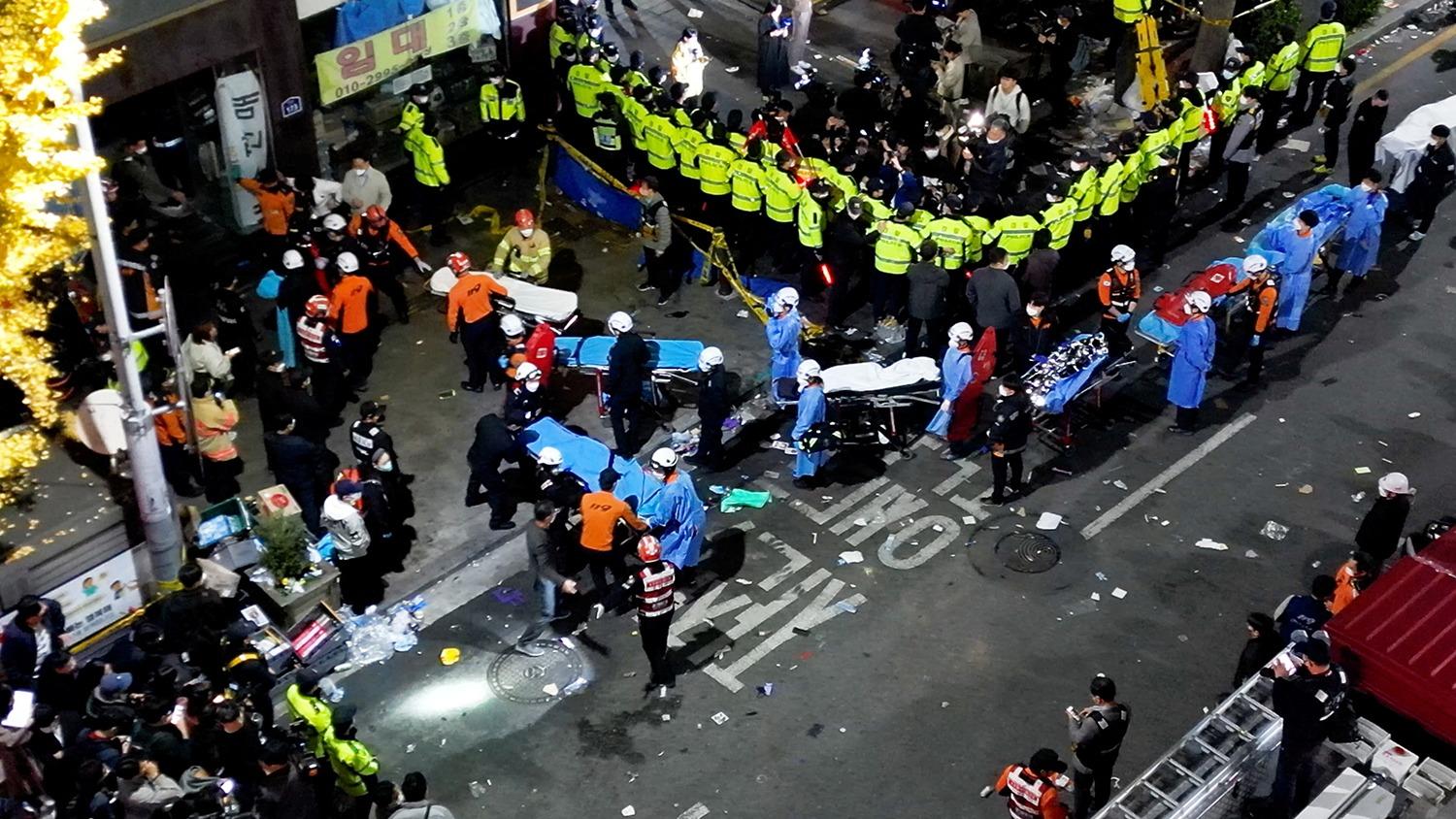 Rescuers work at the scene of the Halloween stampede in Itaewon, Seoul, South Korea. (YONHAP / REUTERS)
Rescuers work at the scene of the Halloween stampede in Itaewon, Seoul, South Korea. (YONHAP / REUTERS)
Apall of death hangs over South Korea as the nation struggles to come to grips with a Halloween celebration in Seoul, on Oct 29, that ended with scores of revelers dying in a stampede.
While grieving relatives continue to mourn and identify their loved ones, ordinary citizens have shown solidarity by placing white mourning flowers and condolence gifts near the alleyways of Itaewon, the popular nightlife district of Seoul, where the tragedy took place.
Release of pent-up stress from the COVID-19 pandemic is being cited as one likely factor in the horrific accident. An overwhelming number of people, mainly the young, headed to the area to celebrate the first Halloween festivities in three years with no social restrictions.
Observers, meanwhile, are blaming insufficient police presence and the fact that there was no organizer behind the mass gathering.
As of 6pm local time on Nov 2, 156 people had died from the accident, according to South Korea’s Central Disaster and Safety Countermeasures Headquarters. Most of the victims were in their 20s, with twelve of them in their teens. There were 172 people injured and undergoing treatment, with 33 of them seriously injured.
The accident marks the deadliest crowd crush in South Korea’s history and the country’s worst peacetime disaster since 2014 when 304 people died in the tragic sinking of the MV Sewol ferry.
A total of 26 foreigners from 14 countries were among the Itaewon victims, including five from Iran, four from China, four from Russia, two from the United States and two from Japan.
As many as 100,000 people dressed up in costumes and gathered in Itaewon to celebrate the country’s first Halloween event after the government lifted COVID-19 restrictions and social distancing rules.
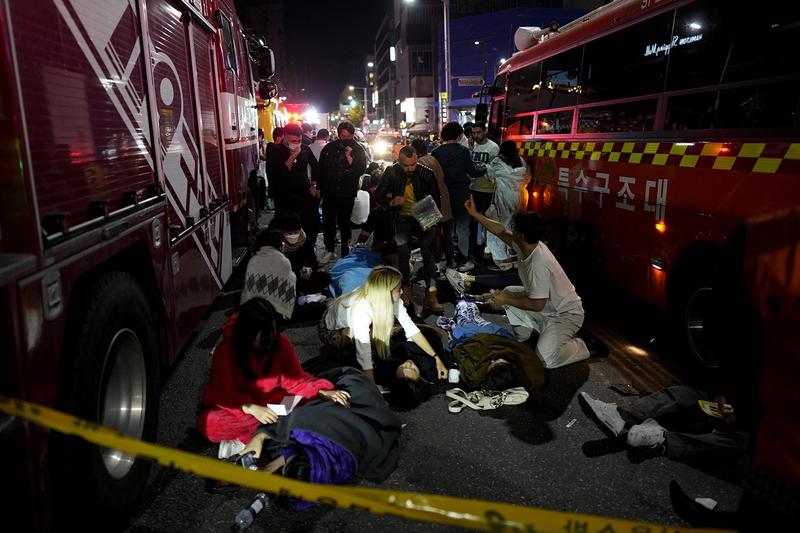 Those injured in the stampede are helped near the scene. (LEE JIN-MAN / AP)
Those injured in the stampede are helped near the scene. (LEE JIN-MAN / AP)
The accident happened around 10:30 pm. People were trapped and crushed as the crowd surged into a downhill alley less than 4 meters wide.
A weeklong national mourning period is being held until Nov 5, with all state and government agencies flying flags at half-mast. The Chinese embassy in South Korea is among the diplomatic missions that expressed condolences to the victims of the tragedy.
Mourning altars laden with white chrysanthemums opened across South Korea to allow people to pay their respects to those killed in the crush. President Yoon Suk-yeol and first lady Kim Keon-hee visited the altar at Seoul Plaza in front of City Hall.
Paying tribute to the victims at the memorial altar at Seoul Plaza, Chinese Ambassador to South Korea Xing Haiming said the stampede accident in Itaewon is very unfortunate and that China is working with the South Korean government in an all-out effort to rescue and assist Chinese citizens.
The Chinese Foreign Ministry has warned Chinese citizens overseas not to go to crowded places and to immediately seek help from local police and Chinese embassies in case of emergency.
Yoon said the government should come up with a crowd control system for unorganized and spontaneous events.
“President Yoon said ahead of the discussions that he feels an indescribable sadness and responsibility as the president responsible for the people’s lives and safety when he thinks of the victims and their families,” deputy presidential spokesperson Lee Jae-myoung told reporters, according to Yonhap News Agency.
“In particular, he once again expressed his grief that so many young people at such a tender age were struck by tragedy before they even had a chance to pursue their dreams,” Lee said.
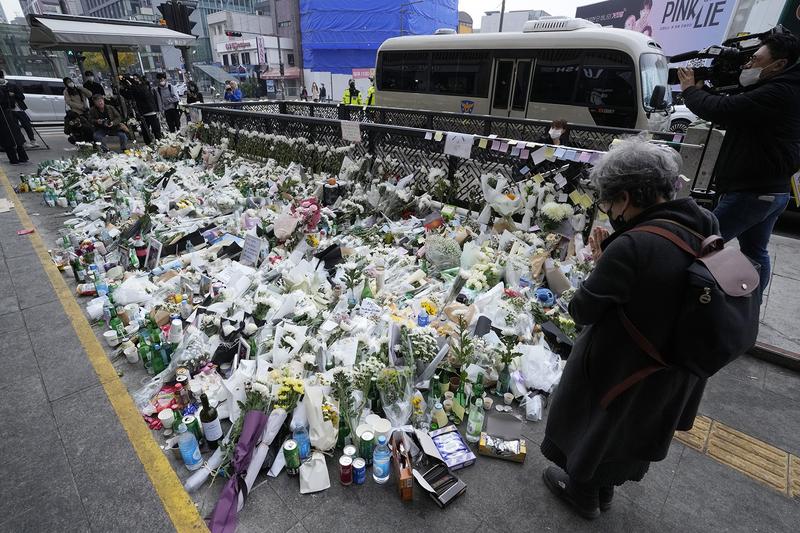 A woman prays for victims of the disaster. (AHN YOUNG-JOON / AP)
A woman prays for victims of the disaster. (AHN YOUNG-JOON / AP)
As investigations over the cause of the accident continue, the ruling People Power Party pledged on Nov 1 to push for a revision of the disaster and safety law to bolster safety management in events without organizers.
“(For other types of events) the organizers could be punished under the law (for mismanagement), but it is difficult for someone to take the blame for the event as this was a voluntary event without an organizer,” Yeom Gun-woong, professor at the Department of Police & Fire Administration at South Korea’s U1 University, told YTN news.
Yeom said the accident was caused by people in the crowd walking through the alley and being pushed against each other, which makes it difficult to determine who is responsible for the disaster.
Lee Young-ju, a professor from the Department of Fire and Disaster at the University of Seoul, said the Halloween gathering in Itaewon was a district event without a specific organizer and thus lacked a safety control system.
“This was a disaster that could have been controlled or prevented. But this was not taken care of, with no one taking the responsibility in the first place,” said Lee Young-ju.
Shin Dong-min, a professor of the Department of Emergency Medical Service at the Korea National University of Transportation, said the Itaewon accident was a man-made disaster prompted by lack of awareness about safety.
“Itaewon vendors and government officials should have had more preparations about a massive crowd gathering,” said Shin.
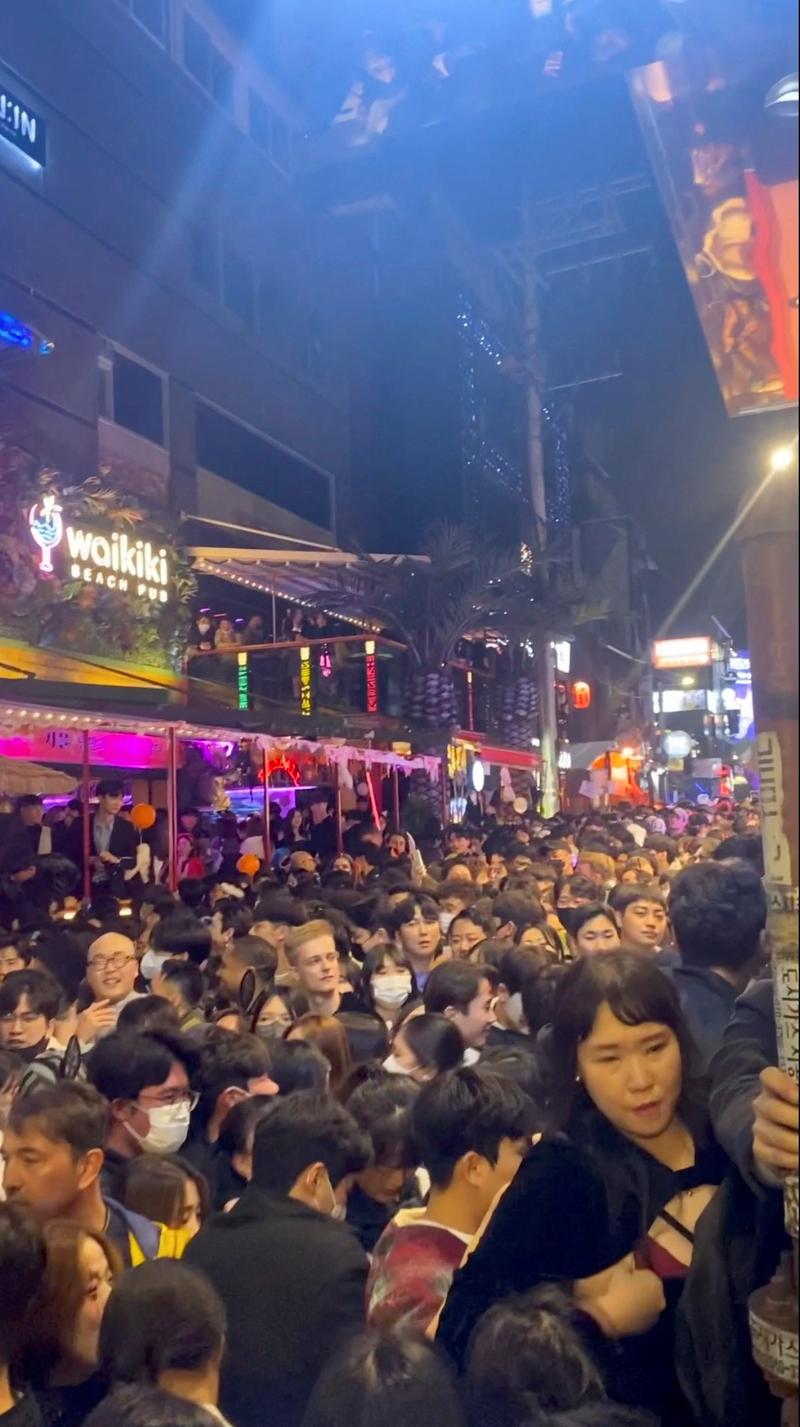 A dense crowd forms during the festivities. (LINDA@DABAKLUSA / REUTERS)
A dense crowd forms during the festivities. (LINDA@DABAKLUSA / REUTERS)
Some witnesses said there were people pushing from behind while walking in the crowd.
“I could feel that people were pushing from the back and it became stronger and stronger,” a Chinese student surnamed Zhao told Hong Kong television broadcaster TVB. “Some people were getting more and more excited … and you could hear many people were screaming.”
To avoid the crowd, Zhao, who finished having dinner with his friends at around 8 pm, went upstairs to a bar before the tragedy took place.
Zhao said he only saw police coming after the accident happened, and that the emergency team arrived only half an hour later.
Another Chinese student, nicknamed Gu Lu Lu Xiao Zhu, posted on social media that she was in the middle of the crowd just before the accident happened.
“It was difficult to stand on my own and I could barely breathe,” she wrote. As she walked along the wall and tried to get away, people began falling down.
After being evacuated to the main road, she saw people lying on the ground, and countless ambulances.
“I will never go to Itaewon again,” she said.
Though the Yoon administration has quickly rolled out measures such as designating a special emergency area around Itaewon, Ha Kyoo-man, a representative of South Korea at the International Association of Emergency Managers, said government officials did not admit immediate responsibility for the late emergency response.
Ha said policymakers in South Korea have not realized the importance of contingency planning for special events such as the Itaewon Halloween gatherings.
Ha said the cause of the Itaewon stampede should be the “irresponsibility of the policemen in the region”.
“The regional police as emergency responders did not pay attention to (the need to) monitor mass gatherings around Itaewon during Halloween festivities,” said Ha.
Ha said the investigation team should consist of all stakeholders — from police investigators, firefighters and medical staff, to vendors in Itaewon, survivors, and victims’ families.
“Multiple perspectives will be fairly reflected to see what was the main cause behind the Itaewon stampede,” said Ha.
Yoon Hee-keun, head of South Korea’s National Police Agency, at a news conference on Nov 1, offered an apology to the public over the crowd crush.
Yoon Hee-keun said police received multiple reports regarding the severity of the crowd but the police response was insufficient. He said the department will release detailed information in the future.
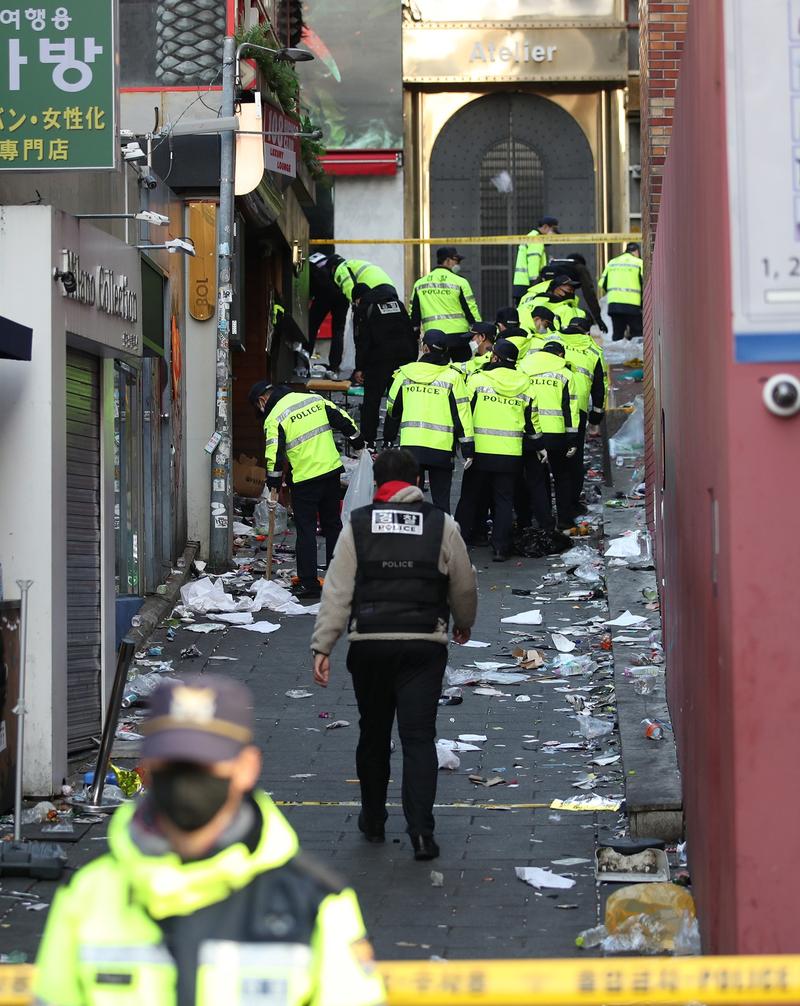 Police investigate at the scene. (PHOTO / XINHUA)
Police investigate at the scene. (PHOTO / XINHUA)
According to details released at the news conference, the police began to receive calls from 6 pm related to Halloween gatherings at Itaewon. Just an hour before the accident, multiple reports were filed regarding the huge crowd at Itaewon and calling for control, but no specific measures were taken.
The national police chief said the department will investigate thoroughly to find out the truth.
About 137 police officers were deployed to Itaewon for Halloween gatherings.
In contrast, on the same day as the accident, at rallies by labor unions and by supporters of President Yoon that drew tens of thousands in Gwanghwamun, central Seoul, up to 4,000 police personnel were deployed, according to Reuters.
The government is working to provide mental health support to people who may have suffered psychological trauma from the crush.
South Korean Prime Minister Han Duck-soo said bereaved families, injured people and ordinary citizens affected by the disaster will be subject to government-organized mental treatment programs.
The Korean Neuro Psychiatric Association, or KNPA, said in a statement that people should stop spreading videos and pictures of the accident scene without filtration.
“It is recommended to refrain from watching excessively and repeatedly the accident videos or news because it can have a negative impact on people’s health,” the KNPA said.
The Korean Society for Traumatic Stress Studies said people should stop criticizing, as public criticism will leave a greater and deeper trauma in the minds of the survivors and the bereaved families.
“Please understand the great pain that the survivors and the bereaved families are undergoing both physically and mentally,” the society said.
Social media and online portal operators including Kakao have asked users to refrain from uploading content that might reveal the victims’ identities, or from sharing unconfirmed information.
The Itaewon accident has raised a global alert on crowd management.
In Indonesia, on Oct 1, more than 170 people were killed in a crowd stampede at a soccer match in East Java province.
Back in 2015, it is estimated that more than 2,000 pilgrims were crushed or trampled to death in a stampede in Saudi Arabia during the annual Hajj pilgrimage in Mina, Mecca.
In India, a stampede broke out on a bridge near the Ratangarh Mata Temple in Datia district, Madhya Pradesh, in October 2013, during the Hindu festival of Navratri, killing 115 people.
“It is certain that the severity of the Itaewon accident has been much related to the impacts of the COVID-19 outbreak,” said Ha from the International Association of Emergency Managers.
Noting that levels of mental stress have been extremely high since the pandemic started in South Korea at the beginning of 2020, Ha said many young people were looking to relieve that stress by participating in Halloween festivities in Itaewon.
“As long as Omicron sub-variants are still mutating, the second or third Itaewon accident may happen anywhere,” said Ha.
Besides the government, Ha said individuals, too, need to be aware of the potential danger in mass gatherings and try to avoid emergency-prone areas.
President Yoon has called a government-civilian meeting next week to discuss and analyze the cause of the Itaewon tragedy and raise suggestions to improve safety measures.


